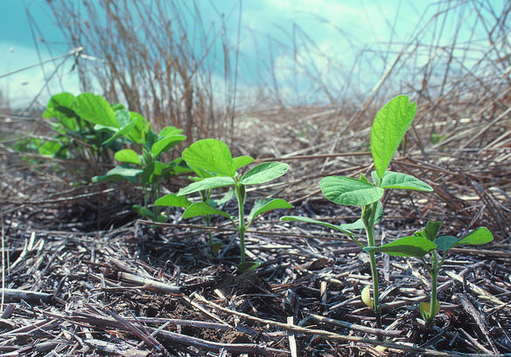To till or Not to Till… That is the question
April 15th, 2016
Contributed by Christine St.Pierre
As the spring season arrives, those of growing our own food are faced with one of the great garden dilemmas and controversies: to till or not to till the soil. Tilling, or digging and turning the soil with a shovel, hoe, rake, or tiller, happens in a garden once or twice a year, when the soil is dry and warm. Those in favor of tilling use this approach in their gardens in order to loosen the soil for better drainage, prevent weeds from growing, and amend the soil with nutrients. Those who adopt the “no till” approach believe the soil will actually be healthier with less manipulation.
Appearing dormant and inactive, your frost-covered garden beds are actually bustling with life throughout the cold winter months. Microorganisms that balance the soil are hard at work boosting soil fertility, health, and structure. Such microorganisms, like bacteria, fungi, and algae, have their own agenda when it comes to soil health, and when left alone to perform their duties, your soil reaches optimum quality, as it would in its most natural state.
This is why many gardeners are in adamant support of the “no till” garden, which approaches seasonal gardening without tilling and turning the soil, so as not to upset the natural order of soil health. This, however, is not a “hands off” approach to gardening or soil maintenance; “no till” gardeners still apply layers of compost, mulch, and other soil amendments to the soil prior to the winter season and throughout, just as decaying plant life and leaves would provide to layers of topsoil in a natural setting.
Soil is naturally resilient; air pockets, created from root systems and layers in the soil, assist in nutrient displacement and drainage, as soil purifies and facilitates water in terrestrial systems. These layers in the soil, or horizons, have different characteristics and different roles to play in soil health. Plants thrive and grow in first two layers of soil, called the humus/organic and topsoil, which are comprised of decomposed plant material and mineral-rich organic matter. Beneficial microorganisms settle into these particular horizon layers in order to break down plant matter into supportable nutrients, produce energy by releasing nutrients such as nitrogen, sulfur, iron, and phosphorus, wear down synthetic pesticides and other harmful soil additives, and defeat pathogenic microorganisms that cause plant diseases.
When you till your garden bed, you also churn up and mix these vital horizon layers, wreaking havoc on soil’s natural systems, particularly in regards to bacteria and microorganisms. When exposed to surface air due to tilling, microorganisms become oxidized and die off. This initially releases a surge of energy in your soil and causes a rapid spike in soil health, but only for a short period of time. Soon, the microorganisms die, causing soil health to plummet and become nothing more than the dirt on our clothes or under our fingernails.
Temperature differentials also greatly affect the microorganisms in soil, which is why those who till must wait until the soil is warm and dry—the rule of thumb is, with every 18 degree rise in temperature, there is a 1.5 to 3.0 percent increase in microbial activity (Carrol/Waddington/Reike). Just as temperature affects microbial activity, so does moisture in the soil. Therefore, turning the soil moves cooler, wetter soil to the top. This warms and dries the newly moved soil, coinciding with the spike in energy that will eventually lead to a complete cessation of activity as the microorganisms die off.
If organic gardening and holistic food are your top priorities, try experimenting with “no till” gardening. Get back to the roots of natural food growth. The key to a successful “no till” garden is preventative treatment rather than curing depleted soil—you must tend to your soil yearlong, including late fall, winter, and early spring. Of course, there are reasons why some gardeners prefer tilling soil, such as large-scale crop production, use of synthetic soil amendments, and a strong belief that that system works best. But, the case for “no till” gardening is on the rise; it saves time, work, and, over time, creates an incredibly healthy and self-sustaining ecosystem in your soil.
Leave a Reply